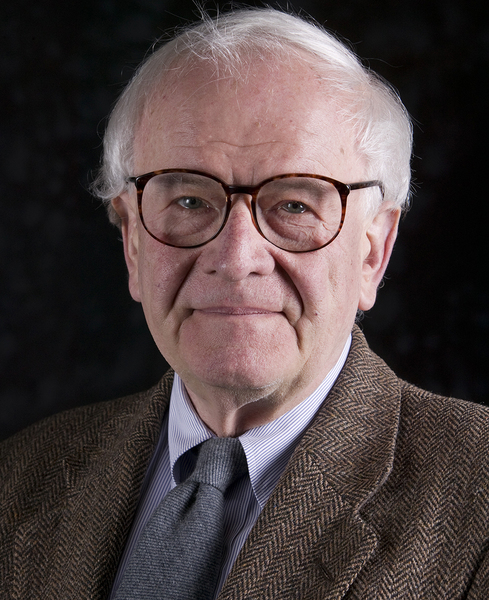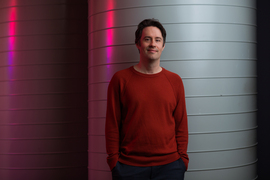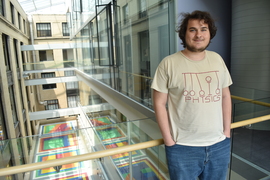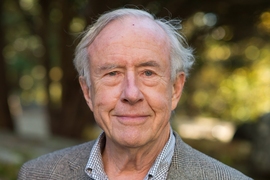Eminent theoretical physicist and Dirac Medalist Roman Jackiw, MIT professor emeritus and holder of the Department of Physics’ Jerrold Zacharias chair, died June 14 at age 83. He was a member of the MIT physics community for 54 years.
A leader in the sophisticated use of quantum field theory to illuminate physical problems, his influential work on topology and anomalies in quantum field theory (QFT) underlies many aspects of theoretical physics today.
Iain Stewart, the MIT Center for Theoretical Physics (CTP) director and Otto (1939) and Jane Morningstar Professor of Science, says that Jackiw “served as an inspiration for what one can achieve as a theoretical physicist. He made profound contributions to physical problems in a wide range of areas, including particle physics, condensed matter physics, and gravitational physics.”
“Professor Jackiw was a pioneer in the field of mathematical physics,” says Nergis Mavalvala, the Curtis and Kathleen Marble Professor of Astrophysics and dean of the MIT School of Science. “His imaginative use of quantum field theory shed light on physical problems, including his work on topological solitons, field theory at high temperatures, the existence of anomalies, and the role of these anomalies in particle physics."
Says Frank Wilczek, a CTP colleague who is the Herman Feshbach Professor of Physics and a 2004 Nobel Laureate, “Roman Jackiw had an uncanny knack for identifying ‘curiosities’ that have grown into fertile, vibrant areas of physics research. His seminal contributions to the theory of anomalies, the interplay of topology with quantum theory, and fractional quantum numbers are a rich legacy which has become central to both fundamental physics and modern quantum engineering.”
“He was a major, major figure in theoretical physics,” Wilczek said to his audience at a conference he attended a day after Jackiw’s death. “Roman was a pioneer in all these subjects, and advanced them greatly, before they became so popular.”
He is renowned for his many fundamental contributions and discoveries in quantum and classical field theories. Among his major achievements is the establishment of the presence of the famous Adler–Bell–Jackiw anomalies in quantum field theory, a discovery with far-reaching implications for the structure of the Standard Model of particle physics and all attempts to go beyond it.
Jackiw shared the Dirac Medal with Stephen Adler of Princeton University for their “celebrated triangle anomaly, one of the most profound examples of the relevance of quantum field theory to the real world,” says the citation from the International Centre for Theoretical Physics. “Jackiw made a major contribution to field theories relevant to condensed matter physics in his discovery (with Boston University’s Claudio Rebbi) of fractional charge and spin in these theories.” They received the medal in 1998 from the International Center for Theoretical Physics in Italy.
“Roman's style was rigorous and mathematically sophisticated, but not pedantic,” says Robert L. Jaffe, the Otto (1939) and Jane Morningstar Professor of Science, Post-Tenure. “After his early groundbreaking work on the ‘triangle anomaly,’ Roman for many years focused on the application of topological methods in quantum field theory. Although Jackiw was not directly involved in the creation of the Standard Model, which revolutionized physics in the last third of the 20th century, the methods of analysis that Roman invented were often essential to its development.”
Bolek Wyslouch, professor of physics and director of MIT’s Laboratory for Nuclear Science, calls Jackiw “a towering figure in theoretical physics — one of the leaders that made MIT and the Center for Theoretical Physics world's first … His foundational work was instrumental in establishing the Standard Model of particle physics, one of the most successful theories in physics.”
Ukrainian roots
Born Roman Volodymyr Yatskiv in Lubliniec, Poland, to a Ukrainian family in 1939, his name was Romanized to Jackiw.
“We stayed in Poland until it became clear that the Russians and the Communists would be the dominant force there, and … my father didn't want to live under those conditions,” recalled Jackiw in an oral history published by the American Institute of Physics. They went to live near his father’s other children, in Austria, and eventually moved to Germany before settling in New York City when Jackiw was about 10.
“I was heartbroken to be leaving (Germany),” said Jackiw. “It’s a town called Dingolfing, probably known these days to car buffs because BMW started in Dingolfing, or had one of its original factories in Dingolfing.”
In New York, he was educated by Xaverian monks in junior high, and Christian brothers in high school. “I became convinced I wanted to be a physicist after reading [George] Gamow’s “One Two Three… Infinity,” recalled Jackiw. “He describes people doing things that sounded fascinating to me and I wanted to do them. It was actually an act of faith because I didn't get to do them until graduate school.”
After graduating from Swarthmore College in 1961, where he majored in physics with minors in history of science and mathematics, he went to Cornell University, where he worked with professors Hans Bethe and Kenneth Wilson and received his PhD in 1966. Jackiw recalled working on a thesis that went against Wilson’s advice.
“He wanted me to use the renormalization group to find the high-energy behavior of form factors in electrodynamics. It turns out that the renormalization group doesn't control that, but other approximations can be used to solve that problem, and I did. My thesis was published and it’s still referred to.”
He had wanted to work with Bethe, but Bethe was doing nuclear physics while Jackiw was more interested in particle physics. However, Bethe asked him to co-author a textbook on quantum mechanics: “Intermediate Quantum Mechanics.” The popular book, most recently revised in 2018, was for many years the basic introduction to the application of quantum mechanics to atomic physics.
From 1966 to 1969, he was a junior fellow at Harvard University. In his second year he went to CERN, working with John Bell. “I discussed current algebra a lot with him,” Jackiw recalled, “and then we fell into the problem of the decay of the neutral pion into two photons, which was a puzzle at that time, and we studied the properties of the axial vector current and discovered the axial vector current anomaly, and wrote a paper, which is my most cited paper and also John Bell’s most-cited Particle Physics paper, in fact.”
At the time, theory seemed to predict that the neutral pion could not decay into two photons, but the decay had been observed in experiments. With the Bell–Jackiw–Adler anomaly, clarified later by Stephen Adler, they “were able to explain the observed decays theoretically by adding an ‘anomalous’ term resulting from the divergences of quantum field theory,” according to an article in Physics World.
In his final year at Harvard, Jackiw had been working with other theorists at MIT. Physics professors Steven Weinberg and Sergio Fubini, together with physics department head Victor Weisskopf, helped to initiate Jackiw’s long career as a professor at the Institute, which began in 1969. In his first years at MIT, Jackiw and David Gross showed that cancellation of gauge anomalies implied an interesting connection between fermions in the Standard Model — in particular, that fermions in two classes, those which are strongly interacting and those which are not, have to appear the same number of times. Over the years this cancellation continued to suggest the existence of new fermions before they were observed.
Jackiw held visiting professorships at Rockefeller University in 1977-78, at the University of California Los Angeles and the University of California at Santa Barbara in 1980, and at Columbia University in 1989-90. He became an emeritus professor in 2013.
An unusual kind of greatness
Jackiw had said he had two bodies of work. The first were “mathematical investigations which fit Dirac’s criterion of beauty and have physical application because they are beautiful, like fractional charge phenomenon that I mentioned earlier, and like the anomaly phenomenon, like the Chern-Simons terms which I introduced with the help of [Stanley] Deser and students and later explored with So-Young Pi.” Pi, currently a Boston University physics professor emerita, is a distinguished physicist who was a co-author on many of Jackiw’s papers, and is Jackiw’s widow.
“But on the other hand, I’ve also done kind of methodological investigations, which weren’t necessarily original but applied existing schemes to new context. Like for example, figuring out how to do quantum field theory at finite temperature and relativistic quantum field theory at finite temperature, taking over what they do in condensed matter physics and non-relativistic quantum field theory approach to condensed matter physics at finite temperature.”
Jackiw was known for working on mathematically intricate physics without an application in mind. “What I’ve always liked is to do work which seems obscure but interesting, and then decades later it catches on,” he said.
“Roman Jackiw was a giant of theoretical physics, but of a somewhat unusual kind,” recalls Daniel Harlow, the Jerrold R. Zacharias Career Development Associate Professor of Physics at the Center for Theoretical Physics. “He was rarely working on the same thing as others, and indeed if something he was doing started catching on then he would often turn to something else. And yet his ideas had a way of growing up: He would leave them lying around, and then a decade or two later everyone else would realize that he had really been on to something.”
For example, Harlow once asked him why he had been studying gravity in two spacetime dimensions. “His response: ‘Well, everyone else was thinking about gravity in more than four dimensions, so I figured I'd see what happens in fewer than four.’"
“His work on low-dimensional gravity from the 1980s has really taken off in the last five years,” says Harlow. “His influence will be felt both here at MIT and around the world for generations.”
David Kaiser, a physics professor and the Germeshausen Professor of the History of Science, says that, while working with a CTP doctoral candidate, “It seems like every other day we discover that Roman had first published on this-or-that piece of what we are trying to figure out, many years ago, in greater generality and with far more elegance than we had ever aspired to. He and his work remain a major inspiration for us.”
Indeed, besides Jackiw’s celebrated work on anomalies, other important examples of his contributions include providing the first example of charge and spin fractionalization with solitons, elucidating the periodic vacuum structure of the non-abelian gauge theories that form the core of the Standard Model of particle physics, launching the use of quantum field theory for the rigorous study of systems at finite temperature, and determining the nature of Chern-Simons terms for both gauge and gravitational theories.
This broad range of research influenced countless others. “To get an appreciation of Roman’s impact on theoretical and mathematical physics, one need only look at how often people refer to him by name in their papers, with examples including ‘Adler-Bell-Jackiw anomalies,’ ‘Jackiw-Teitelboim gravity,’ ‘Fadeev-Jackiw quantization,’ the ‘Jackiw-Nohl-Ressen ansatz,’ and the ‘Jackiw-Rossi,’ ‘Jackiw-Rebbi,’ and ‘Jackiw-Pi’ models,” says Stewart.
Roman had over 30 PhD students, including Estia Eichten (Cornell), Joseph Lykken (Fermilab), and Andrew Strominger (Harvard); he was “a very successful mentor to generations of PhD students who formed a ‘school’ of theoretical physics focused on the use of sophisticated mathematical methods to explore the physical content of quantum field theories,” recalls Jaffe.
Other awards and honors
From 1969 to 1971, Jackiw was honored as an Alfred P. Sloan Research Fellow, and from 1977 to 1978 as a John Simon Guggenheim Memorial Fellow. In 1995 Jackiw received the Dannie Heineman Prize for Mathematical Physics from the American Physical Society “for his imaginative use of quantum field theory to throw light on physical problems, including his work on topological solitons, field theory at high temperatures, the existence of anomalies, and the role of these anomalies in particle physics.” In 2007 he received the Bonnor Essay Prize from Queen Mary University of London.
He was a member of the American Academy of Arts and Sciences, the American Physical Society, and the National Academy of Sciences, and a foreign member of the Ukrainian National Academy of Sciences. Honorary doctorates were also awarded by Turin University, Italy; Uppsala University, Sweden; the Kyiv Bogolyubov Institute, Ukraine; and Montréal University, Canada.
Professor Jackiw wrote six other books: “Lectures on Current Algebra and its Applications” (with S. Treiman and D. Gross); “Dynamical Gauge Symmetry Breaking” (with E. Farhi) 1982; “Shelter Island II” (with N. Khuri, S. Weinberg and E. Witten) 1985; “Current Algebra and Anomalies” (With S. Treiman. B. Zumino and E. Witten) 1985; “Diverse Topics in Theoretical and Mathematical Physics,” 1995; and “Lectures on Fluid Dynamics,” 2002.
“I have immense respect for his legacy and achievement, and greatly appreciate the doors he has opened for the rest of us,” says Stewart.
He is survived by his wife, So-Young Pi, and three children: Stefan Jackiw, a violinist; Nicholas Jackiw, a software designer; and Simone Ahlborn, an educator at Moses Brown School in Providence, Rhode Island. Funeral services will be private.









